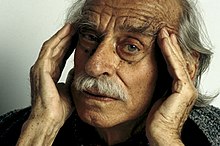Bernard Rudofsky
| Bernard Rudofsky | |
|---|---|
 |
|
| Born |
April 13, 1905 Suchdol nad Odrou, Moravia, Austro-Hungarian Empire |
| Died | March 12, 1988 |
| Nationality | American |
| Occupation | Architect |
Bernard Rudofsky (April 19 1905 - March 12, 1988) was a Moravian-born American writer, architect, collector, teacher, designer, and social historian.
Rudofsky earned a doctorate in architecture in Austria before working in Germany, Italy, and a dozen other countries. He temporarily settled in Brazil in the 1930s and opened an architectural practice there, building several notable residences in São Paulo. An entry in a 1941 design competition brought an invitation from MOMA to tour the US; in the wake of Pearl Harbor, as an Austrian native, he was given the option of staying in the US. He remained based in New York City until his death, although he continued to travel (sometimes for years at a stretch). Rudofsky variously taught at Yale, MIT, Cooper-Hewitt, Waseda University in Tokyo, and the Royal Academy of Fine Arts in Copenhagen. He was a Ford, Fulbright and Guggenheim Fellow.
Rudofsky was most influential for organizing a series of controversial MOMA exhibits in the 1940s, 1950s and 1960s. He is best remembered today for a number of urbane books that still provide relevant design insight that is concealed in entertaining, subversive sarcasm. His interests ranged from vernacular architecture to Japanese toilets and sandal design. Taken together, his written work constitutes a sustained argument for humane and sensible design.
In 'Architecture without Architects' Rudolfsky states that "Architectural History, as written and taught in the Western World, has never been concerned with more than a few select cultures." He attempts to break down our limited idea of this field and briefly introduce the reader to the vast and wise world of 'nonpedigreed architecture' (vernacular, indigenous, and often anonymous). The lessons taught in this world are highly useful to mankind, especially relating to the environmental crisis the world now faces.
Another notable work, Now I Lay Me Down to Eat is an entertaining tour of historical and cultural alternatives to the design problems of everyday life—dining, sleeping, sitting, cleansing, and bathing—and was "neither meant to spread dangerous heresies nor to undermine our birthright to make the worst of possible choices. Rather, it demonstrates by means of random examples that life can be less dull than we make it." By contrasting current western design solutions with earlier practices, he makes our current "solutions" look open to improvement, if not outright ridiculous and arbitrary. For instance, he asks why the standard American-style toilet is effectively a septic humidifier, and why American-style bathtubs are impossible for adults to lie down in and are as a matter of routine permanently fixed two or three feet away from a septic humidifier.
...
Wikipedia
